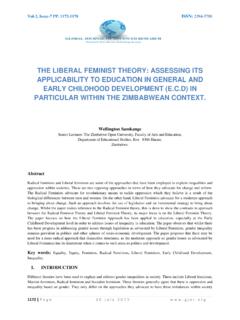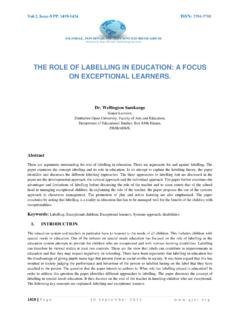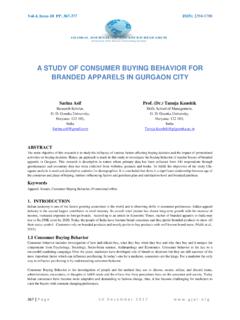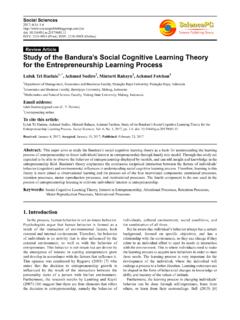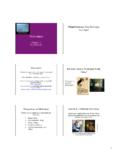Transcription of EXAMINING SKINNER’S AND BANDURA’S IDEAS ON
1 Vol-2, Issue-11 PP. 1858-1863 ISSN: 2394-5788 1858 | P a g e 3 0 D e c e m b e r 2 0 1 5 w w w . g j a r . o r g EXAMINING SKINNER S AND bandura S IDEAS ON LANGUAGE ACQUISITION: IMPLICATIONS FOR THE TEACHER. Dr. Wellington Samkange Senior Lecturer: Zimbabwe Open University: Faculty of Arts and Education; Department of Educational Studies. Box 8306 Harare, ZIMBABWE.
2 ABSTRACT Language acquisition is central to children s learning and development. This paper examines two theories that are related to language acquisition. The theories that are examined are Skinner s behaviourist theory of language acquisition and bandura s social learning theory . Skinner s theory on language acquisition focuses on at least three principles. These are operant conditioning, imitation and reinforcement. bandura s theory of social learning views learning as a cognitive process which has to take place within a social context. Such social context is characterised by observation, reward and punishment. The paper examines the similarities and differences between the two theories.
3 The applicability of the two theories in a classroom set up is also examined. The role of the teacher in language acquisition in relation to the two theories is also discussed. The paper therefore notes that there are no major differences in the application of the theories in the classroom situation as both remind us of the need to create the necessary environment that enables the child to acquire and develop language. It concludes by noting the importance of the theories in language acquisition and development within the classroom situation. Keywords: Operant condition; Language acquisition; behaviourist theory ; development; reinforcement. 1. INTRODUCTION Child development is a continuous process that also involves the development and acquisition of language.
4 Different theories have been used to explain how children acquire and develop language. Among these is the behaviourist theory of language acquisition propounded by such behaviourists like Skinner and Thorndike among others. Their IDEAS formed the early theories of language acquisition. There have also been reactions and responses to these theories by such scholars as bandura and Chomsky. This paper focuses on Skinner s behaviourist theory of language acquisition and bandura s social learning theory . The paper identifies and discusses the two theories on language acquisition. It then discusses the similarities and differences between the IDEAS contained in the theories, before discussing the role of the teacher. The following key terms are defined: IDEAS ; and language acquisition. Vol-2, Issue-11 PP.
5 1858-1863 ISSN: 2394-5788 1859 | P a g e 3 0 D e c e m b e r 2 0 1 5 w w w . g j a r . o r g 2. DEFINITION OF TERMS IDEAS : Within the context of this paper the term IDEAS refers to theories guiding the acquisition of language. Santrock (2010) defines theory as a set of abstract, logically, coherent explanations. We are therefore concerned with the body of knowledge that seeks to explain the acquisition of language as explained by Skinner and bandura . Language acquisition: Tomasello (2008) defines language acquisition as the process through which individuals develop the capacity to perceive, produce and use words to communicate.
6 It is therefore the process by which people develop, retain, produce and use words to communicate. Language acquisition there involves the learning of syntax, semantics, phonetics and vocabulary. 3. SKINNERS IDEAS ON LANGUAGE ACQUISITION Skinner was one of the early behaviourist theorists. According to Weiten (2004), Skinner argued that environmental factors govern language development. Skinner, as a behaviourist emphasized the role of imitation, reinforcement and conditioning in language acquisition. For Skinner, the learning of language was similar to all the other ways children learn all other skills in life. He was concerned with the observable behaviour of organisms, guided by the operant conditioning theory . The acquisition of language is an association between the stimulus, environmental conditions and responses.
7 Lefton (1991) notes that Skinner advocated for reinforcement. Reinforcement involves rewarding desirable behaviour. Reinforcement can be both positive and negative. In language acquisition positive reinforcement involves rewarding of correct utterances. As noted by Ambridge & Lieven (2011) when there is positive reinforcement of correct utterance the child realizes the communicative value of words and phrases. As such, when the child says dad and the caregiver smiles and gives the child some result, the feedback is rewarding to the child as it enhances the child s language development. The reward increases the likelihood of the child repeating the action. On the other hand negative reinforcement involves withdrawing the reward when the utterances are incorrect.
8 According to Skinner conditioning plays a role in the learning and acquiring of language as appropriate behaviour is rewarded. Operant conditioning involves reinforcement and imitation. Imitation involves copying adults language patterns and behaviours. Weiten (2004:312) notes that behavioural theorists like Skinner explain how children learn syntax and learn how to construct sentences by imitating the sentences of adults and older children . This has implications for adults such as teachers. Through imitation children are able to acquire language by making the language of the family and teacher their own. It is important that the teacher plans with the child in mind when teaching language. Since children imitate accent, usage, structure and colloquialism and other related language aspects, the role of the teacher is to ensure that children imitate language that is correct.
9 The teacher should be well trained in the teaching of language and other areas of child development. In this case, the teacher becomes the model. Imitation helps the child in facilitating the internalisation of language. The teacher can also facilitate language acquisition by ensuring that the appropriate responses are reinforced by the correct environmental consequences and by meeting the responses and the needs of the children (Edwards, 2000). The emphasis on the environment by Skinner is of importance to the teacher, in order to facilitate development and acquisition of language. The classroom environment includes the use of games to develop language, training children in listening in order to develop listening skills and oral skills. The classroom and the school environment should help the child to develop vocabulary.
10 This could be in the form of objects and equipment for children to learn and play with. Children play as they learn and learn as they play and the school environment should create a conducive environment. Vol-2, Issue-11 PP. 1858-1863 ISSN: 2394-5788 1860 | P a g e 3 0 D e c e m b e r 2 0 1 5 w w w . g j a r . o r g 4. bandura S IDEAS ON LANGUAGE ACQUISITION bandura advocated for the social learning theory in language acquisition. In the social learning theory , bandura as cited by McLeod (2011) states that in social learning theory , behaviour is learned from the environment through modelling, observation and vicarious learning.
